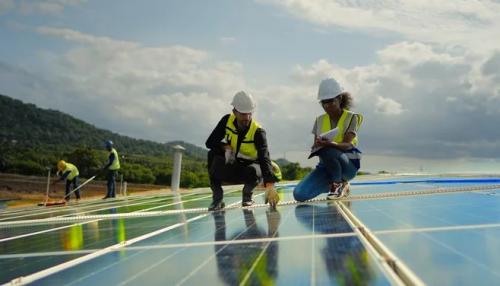Is Sustainable Energy Solutions is Good ?

In an era marked by environmental awareness and the urgent need for climate action, the pursuit of Sustainable Energy Solutions has taken center stage. This comprehensive exploration delves into the transformative landscape of sustainable energy, unraveling innovative technologies, global initiatives, and the collective journey towards a cleaner and more resilient energy future.
Embracing the Power of Renewables
1. Solar Energy: A Radiant Revolution
Solar energy stands tall as a beacon of sustainability, capturing the sun's abundant rays to generate clean electricity. The evolution of solar photovoltaic (PV) technology has not only increased efficiency but also made solar panels more accessible. From residential rooftops to vast solar farms, solar energy continues to redefine the power landscape.
2. Wind Power: Harnessing the Breeze
Wind power, propelled by advances in turbine technology, has emerged as a key player in the sustainable energy mix. Onshore and offshore wind farms harness the kinetic energy of the wind, converting it into reliable and scalable electricity. The towering turbines symbolize a harmonious collaboration between technology and nature.
Energy Storage: The Backbone of Reliability
1. Battery Technology: Empowering Energy Resilience
The evolution of battery technology has revolutionized energy storage, a crucial aspect of sustainable energy solutions. Lithium-ion batteries, coupled with emerging technologies, enable efficient storage of excess energy generated during peak production. This stored energy acts as a buffer during periods of low renewable energy generation, ensuring a continuous and reliable power supply.
2. Hydrogen Energy Storage: A Viable Frontier
Hydrogen energy storage is gaining prominence for its potential to address long-term and large-scale storage needs. Through electrolysis, surplus electricity is used to produce hydrogen, which can be stored and later converted back into electricity. This innovative approach mitigates the intermittency challenges associated with renewables, contributing to grid stability.
Smart Technologies for Grid Optimization
1. Smart Grids: Navigating the Energy Landscape
The integration of smart grid technologies marks a paradigm shift in energy distribution and management. Smart grids utilize real-time monitoring and communication to optimize energy flow, enhance grid reliability, and seamlessly incorporate renewable energy sources. The result is a dynamic and adaptive energy infrastructure for the modern era.
2. Demand Response: Empowering Consumer Choices
Demand response programs empower consumers to actively participate in sustainable energy practices. By adjusting energy consumption during peak demand periods or in response to pricing incentives, individuals and businesses contribute to grid stability. This collaborative approach aligns with the vision of a more responsive and resilient energy ecosystem.
Electrifying Transportation: Redefining Mobility
1. Electric Vehicles (EVs): Driving the Transition
The electrification of transportation represents a pivotal stride towards sustainability. Electric vehicles, powered by high-capacity batteries, offer a clean alternative to traditional internal combustion engine vehicles. The expanding infrastructure for EVs fosters a shift towards sustainable mobility, reducing carbon emissions and dependence on fossil fuels.
2. Mass Transit Electrification: Greening Urban Mobility
Beyond individual vehicles, the electrification of public transportation systems contributes to cleaner urban air. Electric buses and trains, fueled by renewable energy sources, align with the vision of sustainable and inclusive transportation. Electrified mass transit is a key element in building eco-friendly and accessible urban mobility solutions.
Energy Efficiency and Conservation Measures
1. Energy-Efficient Buildings: Greening the Built Environment
Energy efficiency measures play a crucial role in sustainable energy solutions. From building retrofits to green design principles in new constructions, the focus is on minimizing energy consumption. Smart technologies, such as energy-efficient appliances and home automation, contribute to creating environmentally conscious living spaces.
2. Industrial Efficiency: Reducing Carbon Footprints
Electrifying industrial processes and adopting energy-efficient technologies are integral to sustainable energy solutions. From manufacturing to heavy industry, the emphasis is on reducing reliance on fossil fuels and minimizing carbon footprints. This commitment aligns with global efforts to transition towards greener and more sustainable industrial practices.
Community-Centric Energy Initiatives
1. Community Solar Programs: Sharing the Sunshine
Community solar programs democratize access to clean energy. Shared solar installations enable residents and businesses without suitable rooftop space to benefit from solar energy. These community-centric i
Post Your Ad Here
Comments